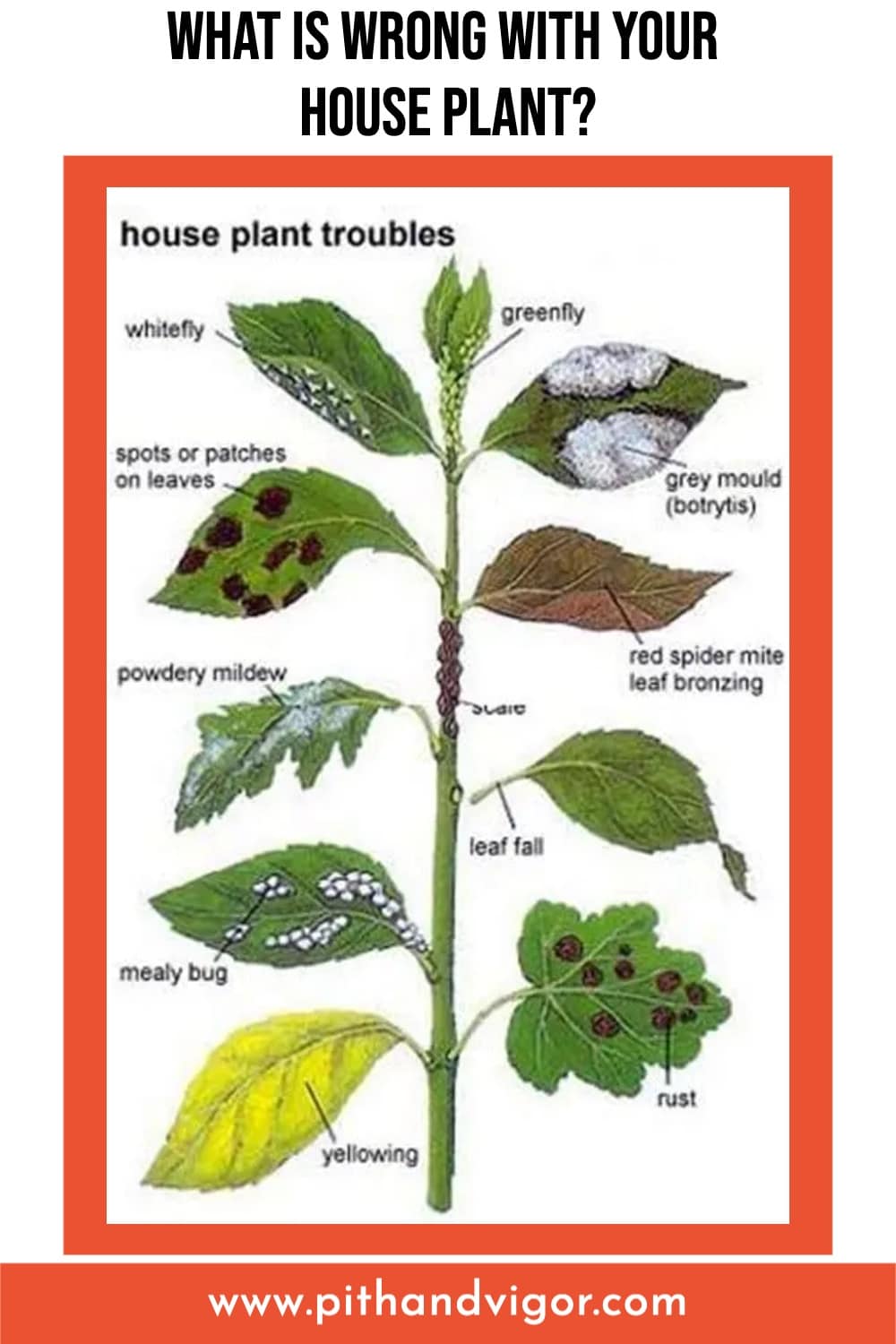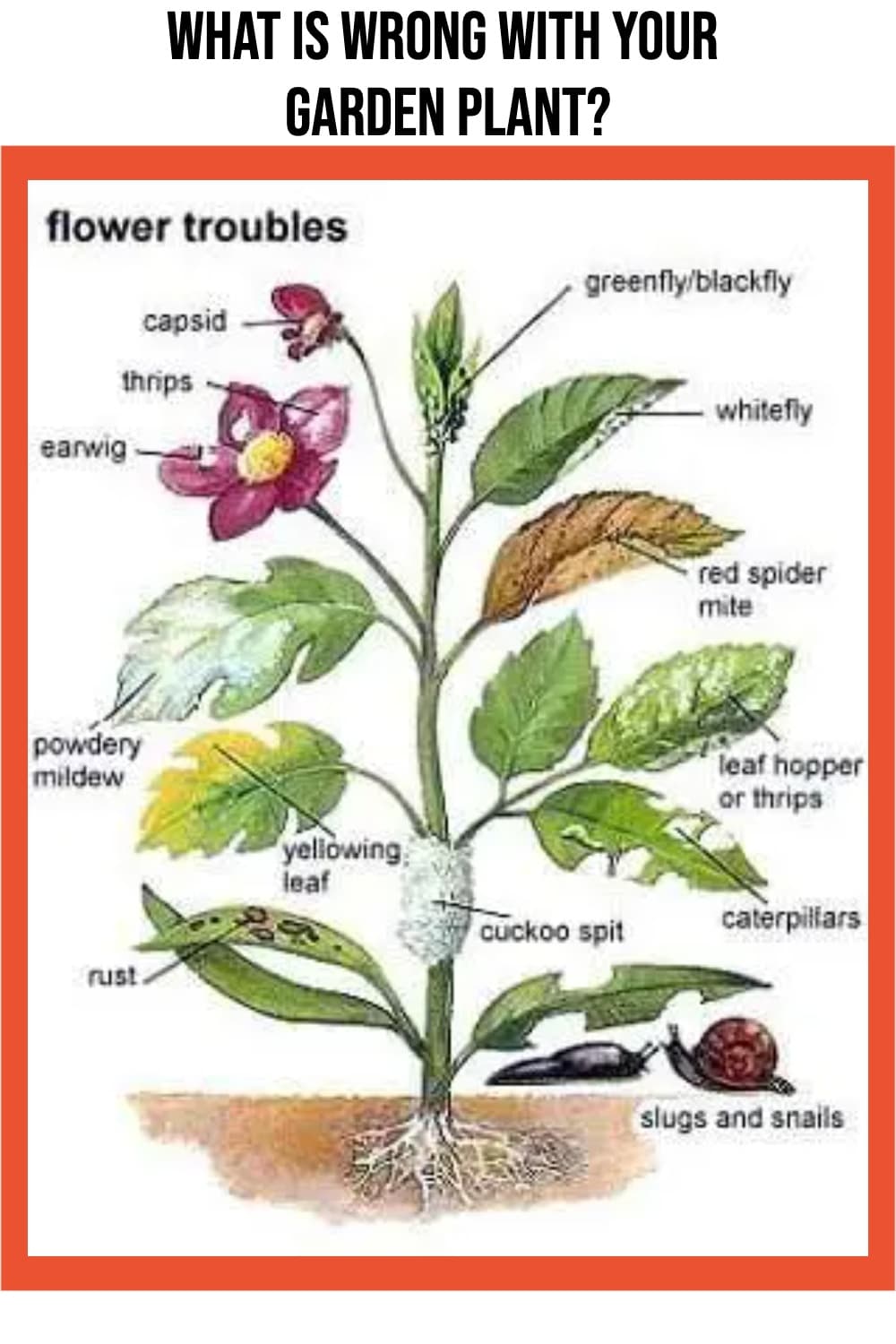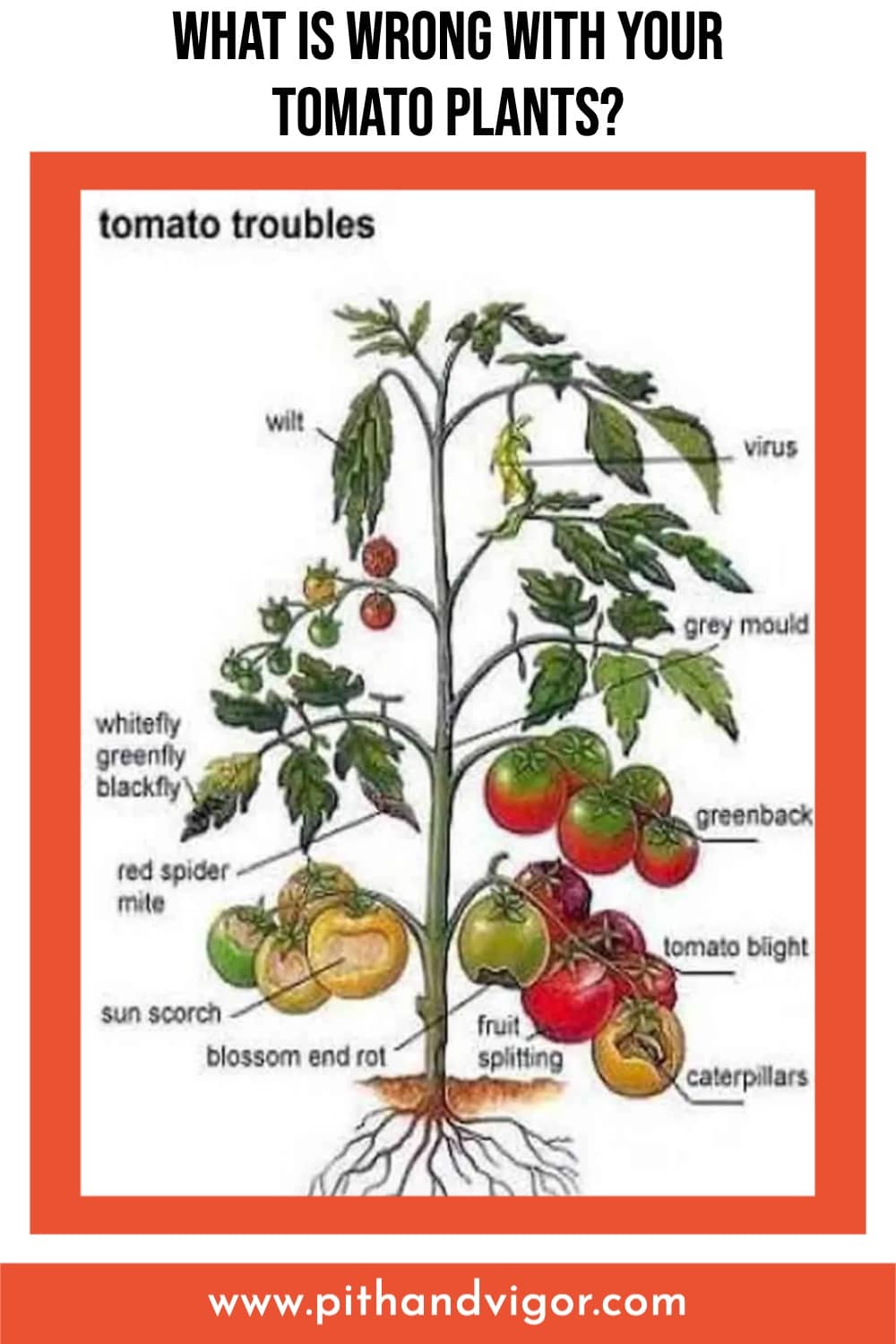Welcome to the post that gets the. Most. Pinterest. Traffic. On. This. Site. – NO MATTER WHAT I DO! It seems that lots of people have weird, manky, dying plant problems, and you are one of them! (you are not alone!).
But it has to be said – I identify as a garden designer (helping you design a great garden is my primary talent). However, I’ve been making gardens my whole life and have nurtured millions of plants. (Both professionally and just because it is my thing). So, putting on my gardener hat here (as opposed to garden designer) – I hope this list of common problems with your house plants and houseplant pests, garden plants, and tomatoes will help you quickly identify and understand what to do about each of the myriad of possible things you might see on your plants.
You’ve got plant problems, and this post will help. But after we’ve solved the pressing plant issue, I hope you stay around or come back soon to learn more about garden design.
You will find that 90% of the issues you see with your plants can be solved with some sort of spray, BUT it is worth mentioning that with better design, you will need less spray.
A well-designed garden is a place that is in better balance with nature (and your lifestyle), and it works to help plants, animals, and you thrive. Let me quickly bottom line gardening for you – thriving plants are less likely to suffer from pests and disease (learn more about why plants die and how to stop killing them), and if you have a good design, your plants will be healthier, and you won’t need as many chemical interventions.
So, let’s solve some plant problems:
What is wrong with my plant?
I originally found these excellent illustrations on the Johnstown Garden Center website. They are the clearest, most easily read depictions of all that could ail you (or your plants) in the garden. Use them to diagnose and then with some authority and hopefully a little bit more confidence, go to a pro (at a good garden center near you) and describe the plant issue and get the right help.
Houseplant problem solver:

Here is your houseplant pest identification guide:
Green fly: Green flies, also known as aphids, are small insects that suck the sap from houseplant leaves. To get rid of these common houseplant pests, you can use organic insecticidal soap or neem oil spray to control and eliminate them. Additionally, regularly inspect and clean your plants, and if the plant can be outside, consider introducing beneficial insects like ladybugs or lacewings that feed on aphids.
White fly: White flies are small, flying insects that feed on plant sap and leave a sticky residue behind. To address this problem, you can use sticky traps to catch adult white flies and insecticidal soap or neem oil to control the larvae. Introducing natural predators like parasitic wasps or applying a reflective mulch* around the plants can also help control white fly populations.
Spots or patches on leaves: Spots or patches on leaves can be caused by various issues like fungal or bacterial infections, nutrient deficiencies, or environmental stress (see what I said about garden design solving problems before they even start!). To fix this, identify the specific cause by examining the size, color, and pattern of the spots. Treat fungal or bacterial infections with fungicides or bactericides, address nutrient deficiencies through balanced fertilization (compost!), and maintain optimal growing conditions by providing adequate light, water, and ventilation (I teach all about how to maximize all of this in my garden design courses).
Grey mould: Grey mold, caused by the fungus Botrytis cinerea, appears as fuzzy grey or brown patches on leaves, stems, or flowers. To combat grey mould, remove and dispose of affected plant parts, improve air circulation around the plant, and avoid over-watering. Applying a fungicide specifically formulated to target grey mold can also help control fungal growth.
Powdery mildew: Powdery mildew is a common fungal disease that forms a white, powdery coating on leaves and stems. To treat powdery mildew, remove heavily affected plant parts, improve air circulation, and ensure proper spacing between plants. Apply a fungicide designed to combat powdery mildew, or use organic alternatives like neem oil or a baking soda solution**.
Regularly monitoring and promptly treating affected plants can prevent the spread of the disease.
Also, while powdery mildew isn’t cute, it isn’t usually deadly, and depending on where you live, it might be unavoidable. In my garden, there are certain plants (a dogwood tree and peonies after they have bloomed) that just get mildewy every single year at some point in the summer – it is a battle I’ve given up fighting, and I’m much happier for it (and the plants are just fine).
Red spider mite: Red spider mites are tiny pests that feed on plant sap, causing leaves to turn yellow and develop stippling or webbing. To control red spider mites, increase humidity levels around the plant by misting or placing a tray of water nearby. Wash leaves with a strong jet of water to dislodge mites, and consider using insecticidal soap or neem oil. Biological controls like predatory mites can be introduced to manage severe infestations.
Leaf bronzing: Leaf bronzing is as it sounds – when leaves develop a bronze or metallic sheen, usually due to excessive light exposure or nutrient imbalances. To address leaf bronzing, adjust the plant’s positioning to provide it with the appropriate amount of light. Ensure that the plant is receiving adequate nutrients by fertilizing with a balanced plant food or by mulching with compost. If necessary, consider repotting the plant in fresh, well-draining soil and adjusting the watering routine to prevent waterlogging or drought stress. (see why plants die)
Mealy bug: Mealybugs are small, white, cottony insects that infest houseplants, sucking sap and causing damage. To eliminate mealy bugs, you can physically remove them using a cotton swab dipped in rubbing alcohol or soapy water. You may also use insecticidal soap or neem oil to control their population. For severe infestations, consider introducing natural predators like ladybugs or applying a systemic insecticide.
Yellowing: Yellowing leaves can be caused by various factors, including nutrient deficiencies, overwatering, underwatering, or pest infestations. To address yellowing, examine the plant’s watering routine and adjust it accordingly, ensuring proper drainage. Evaluate the light conditions and provide adequate or filtered light as needed. Identify any nutrient deficiencies and provide appropriate fertilization. If pests are present, follow the specific recommendations for their control mentioned earlier.
Rust: Rust is a fungal disease that appears as orange or brown powdery spots on leaves, often causing them to wither and drop prematurely. To manage rust, remove and dispose of infected leaves to prevent the spread of spores. Ensure proper air circulation and avoid overhead watering, as wet conditions can promote fungal growth. Apply a fungicide formulated to control rust, following the instructions carefully. Regularly inspect and monitor your plants to catch and treat rust early.
Leaf fall: Leaf fall can have multiple causes, including environmental stress, overwatering, underwatering, nutrient deficiencies, pests, or diseases (it’s basically the same as yellowing). To address leaf fall, assess the plant’s watering routine and adjust it to maintain proper moisture levels. Check for signs of pests or diseases and treat them accordingly. Ensure your plant is receiving adequate light and nutrients. Address any environmental factors, such as temperature fluctuations or drafts that may be causing stress. If the leaf fall persists or worsens, consider consulting a local gardening expert for a thorough assessment and tailored advice.
Note: For any houseplant issues, it’s important to properly identify the problem before implementing a solution. Different plants have different needs, and each situation may require specific treatments, so it’s beneficial to research or consult with a local gardening expert for tailored advice.
…
Garden Plant Problem Solver:
Some of the issues you might find with outdoor garden plants are the same as those with your indoor plants. I’m not going to repeat those issues in this or the next section about tomatoes… just look above if you don’t see the description below.

Slugs and Snails: Slugs and snails can damage garden plants by chewing on leaves and stems. To control them, you can employ various methods such as handpicking them off the plants, creating physical barriers like copper tape or crushed eggshells around vulnerable plants, or using organic slug and snail baits. Additionally, maintaining a tidy garden by removing debris and hiding spots can help reduce their populations.
Thrips: Thrips are tiny, slender insects that feed on plant tissues, causing distorted leaves and silvering or bronzing. To manage thrips, you can use insecticidal soap or neem oil spray to target them directly. Introducing beneficial insects like predatory mites or lacewings can help control thrips populations naturally. Regularly monitoring and promptly treating affected plants can prevent the spread of thrips.
Capsid: Capsid bugs are small, sap-sucking insects that can cause distorted growth and brown or yellow spots on leaves. To control capsid bugs, you can manually remove them from plants or use insecticidal soap or neem oil to deter them. Introducing beneficial insects like ladybugs or hoverflies can also help control their populations. In severe cases, consult with a local gardening expert for specific recommendations.
Earwig: Earwigs are nocturnal insects that can chew on leaves, flowers, and fruits. To manage earwigs, you can set up traps such as rolled-up newspaper or cardboard tubes filled with straw or shredded paper. These traps can be placed near affected plants and emptied daily. You can also create a barrier around vulnerable plants using diatomaceous earth or petroleum jelly on plant stems.
Greenfly/Blackfly: Greenflies and blackflies, also known as aphids, are common pests that suck sap from plants and reproduce rapidly. To control them, you can use insecticidal soap, neem oil, or strong jets of water to remove them from plants. Introducing natural predators like ladybugs or encouraging beneficial insects with diverse plantings can help keep aphid populations in check.
Leaf Hopper: Leaf hoppers are small hopping insects that feed on plant sap and can cause yellowing or stippling on leaves. To manage leaf hoppers, you can use insecticidal soap or neem oil to deter them. Introducing predatory insects like lacewings or pirate bugs can also help control their numbers. Pruning and removing heavily infested plant parts can reduce leaf hopper populations as well.
Cuckoo Spit: Cuckoo spit is the protective foam produced by the nymphs of froghoppers, which suck sap from plants. To address cuckoo spit, you can simply spray it off with a strong jet of water. The foam serves as protection for the nymphs, so removing it will expose them to the elements and natural predators.
Caterpillars: Caterpillars can eat leaves, flowers, and fruits, causing significant damage to garden plants. To control caterpillars, you can manually pick them off the plants and destroy them. Applying organic insecticides like Bacillus thuringiensis (Bt) can effectively target caterpillars while being safe for beneficial insects. Creating physical barriers like netting or row covers can also prevent them from accessing plants. Regular inspection and early intervention are crucial for effective caterpillar control.
Note: Always consider using organic and environmentally friendly methods for pest control whenever possible. Integrated Pest Management (IPM) techniques, including proper plant care and encouraging natural predators, can help maintain a healthy balance in the garden.
…..
Tomato Plant Problem Solver:

Tomatoes are probably the most popular vegetable for home gardeners and they come with thier own set of issues. This section – dedicated to specific tomato problems – covers the maladies that you might encounter when cultivating these delicious fruits.
Wilt: Tomato wilt can be caused by fungal or bacterial pathogens, such as Fusarium or Verticillium. To address wilt, choose wilt-resistant tomato varieties if available. Rotate crops yearly to prevent the buildup of pathogens in the soil. Ensure proper drainage and avoid overwatering. If the disease is detected, remove and destroy affected plants, and avoid planting tomatoes in the same location for several years. Don’t compost infected plants.
Virus: Tomato plants can be affected by various viral diseases, such as Tomato mosaic virus or Tomato yellow leaf curl virus. Prevention is key, so start with disease-resistant tomato varieties. Control the spread of viruses by regularly inspecting plants for symptoms and promptly removing and destroying infected plants. Practice good sanitation by disinfecting tools and washing hands between handling plants. (Don’t compost these either… it will come back!)
Greenback: Greenback is a condition where the tops of tomatoes remain green, leading to poor ripening. To prevent greenback, ensure that plants receive adequate sunlight by pruning excessive foliage. Maintain consistent watering practices to prevent stress. Providing proper nutrient balance through fertilization can also help reduce the occurrence of greenback. Tomatoes will also ripen in the days after you pick them, I tend to keep a constant rotation in my kitchen window during the harvesting season and I always have new fruits ripening.
Tomato blight: Tomato blight, caused by fungal pathogens like Phytophthora infestans, can quickly devastate tomato plants. To manage blight, use disease-resistant tomato varieties and practice proper plant spacing for adequate airflow. Water plants at the base to prevent splashing water onto leaves. Apply fungicides labeled for blight control according to the instructions. Promptly remove and destroy infected plant parts to prevent the spread of spores. All that said – heirloom varieties are by definition not breed to be blight resistant – but they are worth growing. Sometimes blight happens… and when it does, there are farmers markets.
Blossom end rot: Blossom end rot is a physiological disorder caused by calcium deficiency or uneven watering, resulting in dark, sunken spots at the bottom of tomato fruits. To prevent blossom end rot, maintain consistent soil moisture by watering evenly. Avoid over-fertilization with nitrogen, which can hinder calcium uptake. Mulching can help regulate soil moisture. Correct calcium deficiencies by applying calcium-rich amendments or using foliar sprays.
Fruit splitting: Fruit splitting occurs when tomatoes rapidly absorb water after a period of drought, causing the skin to crack. To prevent fruit splitting, maintain consistent watering practices, providing regular but moderate amounts of water to prevent drought stress. Mulching can help retain soil moisture. Harvest tomatoes promptly when ripe to avoid overhydration.
Sun scorch: Sun scorch occurs when tomatoes are exposed to intense sunlight, leading to sunburn and browning of fruits. To prevent sun scorch, provide shading for tomato plants during periods of extreme heat or intense sunlight. You can use shade cloth or strategically position plants to take advantage of natural shade. Avoid excessive pruning, as foliage provides some protection from direct sunlight.
Note: Proper cultural practices, such as choosing disease-resistant varieties, providing adequate water and nutrients, and monitoring plants for early signs of disease or stress, are crucial for maintaining healthy tomato plants.
…..
*Reflective mulch can be made in a couple of ways. You can cut up small strips of aluminum foil and mix them with your mulch, or you can cover some cardboard with tin foil and place it under your plants. The shiny foil will reflect light, deterring some light-sensitive pests. The foil will also reflect nourishing light back onto your plants, but be careful not to burn plants on particularly hot days.
** To make a baking soda solution, add a teaspoon of baking soda and a teaspoon and a half of non-detergent soap to a gallon of water. Mix and spray liberally on the plants.
And finally – if you landed on this post looking for more information about the treasures at the Johnstown garden center in Ireland, check out this post – There are some fun and interesting plants there that I don’t get too see too often where I live (in New England).
You might also be interested in:
HI…long story short – found your site months back searching for garden stuff – been “normally” obsessed with your blog – i go to most, if not all of the sites you mention – and now i am in horticulture science in college and changing my major! I LOVE THE GARDEN!!! You should try and browse Rogers Garden, Corona Del Mar CA http://www.rogersgardens.com/ – great stuff, you can just walk around it is set up like a garden and OOO so relaxing…AND look at the Christmas/holiday stuff! * Plant Depot is a great place too http://www.plantdepot.com/site/! Have fun searching!!
Thank you so much for the twitter plug
jim
Hello Rochelle,
Great article glad you followed through on my tweet just goes to show people are listening out there. I just came across this article by pure accident from someone who logged onto our http://www.fitzgerald-nurseries.com website link from this article. Such a small world 🙂 and so good to see the diversity. Your blog and website are fantastic amaziing amount of work! Well done.
Pat.
I have a garden in Ireland and I have trouble with my rose bushes, the leaves have large brown spots and fall off. What can I give the soil or what can I spray on the leaves?
I have a grafted weeping pussy willow which is only but a foot tall ,( it was indoor plant )all of a sudden the leaves all started dying and the stem turned black up to the grafted area , I can’t find a single thing on how to save my tiny enchantment tree?! Can you suggest anything ?
I have a weeping pussy willow that need something I can’t tell what it is but hopefully you can help me …
It’s brown and I have seen little red bugs before and some kind of reddish egg sac growing on the pansies that I put in the same spot ? Please help